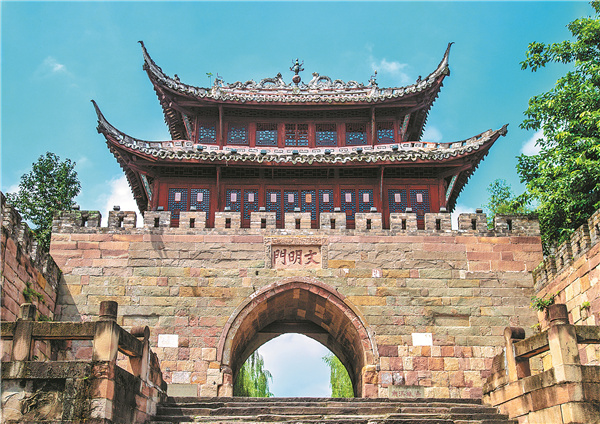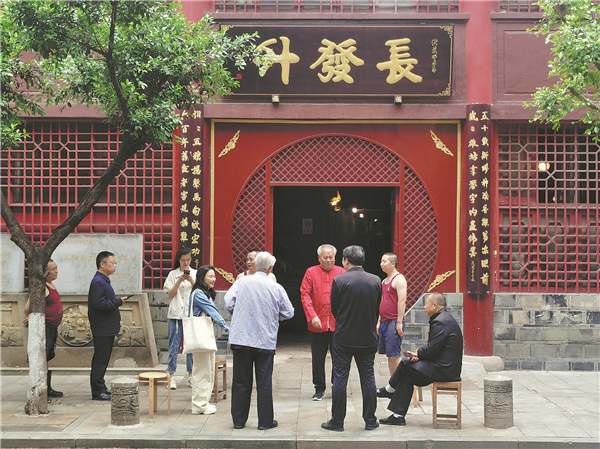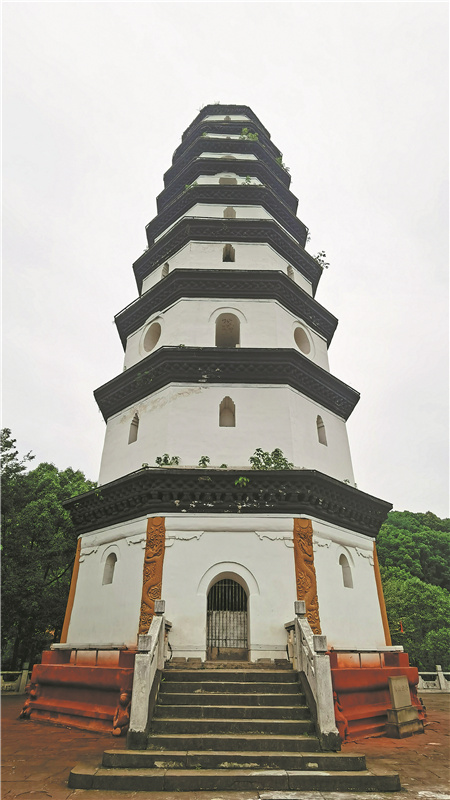A city tower and gate first built in the Ming Dynasty(1368-1644)in the Nanxi district of Yibin, Sichuan province. [Photo/China Daily]
Sichuan tourist destination holds a variety of cultural surprises, Huang Zhiling and Peng Chao report.
Tourists looking to explore Yibin in Southwest China's Sichuan province will be surprised by the diverse ancient architecture, natural beauty, cultural history and historical figures found all around the region.
For first-time visitors who stay in a hotel in the center of Yibin, one of the first things they will pass is an impressive ancient building.
The spectacular 260-year-old Daguan Tower, meaning"grand view"tower in Chinese, looks so unusual at first sight and reminds visitors of China's imperial past, says Jia Yuan, a young visitor from Beijing.
Known as the first city along the upper reaches of the Yangtze River, Yibin boasts many ancient buildings that appeal to history buffs.
The city is situated at the confluence of three major rivers and one popular tourist destination is a large platform in the city center where visitors can see how the Jinsha and Minjiang rivers converge into the Yangtze River.
Standing on the platform, visitors can raise their heads and see an ancient white pagoda in the White Pagoda Mountain Park.
The eight-floor brick pagoda with a height of 35. 8 meters was built in 1569 for local religious people, men of letters and scholars to store their classics, according to an illustration in the park.
In January 2001, the Cuiping district government of Yibin built a sight-viewing platform around the pagoda. Ever since, it has been an optimal site for appreciating both the city and river scenes below.
Yibin is a well-lit city and the night scene below the platform is breathtaking, Jia says.
With an area of 5. 4 square kilometers and 80 percent of its territory covered with trees and plants, the park draws visitors with its pagoda, helping visitors to forget the hustle and bustle of metropolises like Beijing, he says.
About 3. 5 km from the pagoda is the famed Liubei Pond Park. Liubei means"flowing cup"in Chinese.
The park is a must for literature lovers because of Huang Tingjian, a poet from East China's Jiangxi province of the Northern Song period(960-1127)whose three-year stay in Yibin had him reciting and writing poems with friends beside the pond.
The pond is in a zigzag shape with nine curves. It is said that Huang and his friends had to drink the liquor in a cup and pen a poem whenever the flowing cup stopped near one of them.
The"first bend"of the Yangtze River, which passes through Nanxi district. [Photo / China Daily]
High on both sides of the pond are imposing odd rocks on which are 128 ancient inscriptions by famous ancient men.
The mention of liquor reminds visitors of Wuliangye, one of China's best-known liquor brands in Yibin, which has an over 4, 000-year history of production. Wuliangye Group is a mega-sized State-owned enterprise with liquor as its primary business.
With rich biodiversity, Yibin boasts the perfect environment for the microorganisms used for liquor-making to live and reproduce, accredited by UNESCO and UNFAO as one of the most suitable areas for the production of high-quality pure distilled liquor.
Made from sorghum, rice, glutinous rice, wheat and corn with ancient recipes, Wuliangye is one of the world's earliest spirits. It is produced with five grains, and represents China's strong aroma style of liquor. It has been enlisted into the first batch of products protected under the landmark China-EU Agreement on Geographical Indications.
With a planned size of 18 sq km, its industrial park is accredited as a National AAAA-rated scenic spot open to visitors free of charge.
In the park that is of the size of an awe-inspiring small city, visitors who enjoy ancient buildings are mostly attracted by the Changfasheng distillery located on a tranquil street within walking distance from where the Jinsha and Minjiang rivers converge into the Yangtze River.
Workers still toil inside the ancient building of Changfasheng, which has fermenting pits dating back to the Ming Dynasty. Inside, the distillery still resembles what it was hundreds of years ago.
The company has a large number of pits for continuous fermentation and uninterrupted use. Its fermentation pits have an uninterrupted production time of up to 656 years.
One cellar's mud with the microbial community from Changfasheng dating back to the early Ming Dynasty is part of the permanent collection of the National Museum of China and is the only"living cultural relic"in the collection of the museum, says Sun Yiling, a member of the integrated media center of Wuliangye Group, which is in charge of the company's publicity.
In a 30-minute taxi ride from Changfasheng, visitors find themselves at Lizhuang, one of China's historically and culturally famous towns.
Sitting on the southern bank of the Yangtze River and 27 km from Yibin Airport, Lizhuang has a history of 1, 478 years, with well-preserved ancient streets and lanes.
In the Yuwang Temple, visitors can marvel at one 200-year-old stone carving of nine dragons, which looks quite similar to that of the Palace Museum in Beijing.
The Changfasheng distillery has the oldest of Wuliangye's fermentation pits, built during the Ming Dynasty. [Photo / China Daily]
On the 24 window bars of the main hall of Zhang's Ancestral Temple built in 1839 and covering 4, 000 square meters, there are 48 carved cranes around which are hollowed-out cloud patterns.
The crane figurines have 48 different postures, either spreading their wings, flying or looking for food.
In addition to ancient architecture, Lizhuang is best known as an academic refuge during the War of Resistance Against Japanese Aggression(1931-45).
After the Lugou Bridge Incident in Beijing on July 7, 1937, Japanese troops started an all-out invasion of China.
To take refuge, people from important Chinese institutions such as the Central Research Institute and preparatory office of the Central Museum in Nanjing, Jiangsu province, which was the seat of the Kuomintang government, and other institutions of higher learning like the National Tongji University—today's Tongji University in Shanghai—stayed in Lizhuang from 1940 to 1946.
After their campus in Shanghai was destroyed by Japanese warplanes, the teachers and students of the National Tongji University passed through nine Chinese provinces and Vietnam, traveling more than 11, 000 km before settling down in Lizhuang, which was beyond the range of the Japanese military, in 1940, thanks to the help of Qian Zining, a graduate of the university who was the boss of a papermaking factory in Yibin.
Lizhuang, which covered an area of 1 sq km, had 3, 000 inhabitants at the time. To accommodate 12, 000 students and scholars, locals provided them with homes and temples as teaching buildings and residences, according to Fan Wangna, a town guide.
As the Japanese army never entered Sichuan, the National Tongji University continued enrolling students in Lizhuang and the institutions that relocated staff were able to continue working.
Adhering to the belief of saving the country with science and serving the country with academics at a time marked by a shortage of materials and the struggle against poverty, scholars never stopped learning or researching.
Forty-three people who worked or studied in Lizhuang in the 1940s later became academicians of the Chinese Academy of Sciences and the Chinese Academy of Engineering, says Li Chun, head of the Lizhuang Ancient Town Administrative Committee.
One of them is Wu Mengchao(1922-2021), who studied at the National Tongji University's medical college.
Known as"the father of hepatobiliary surgery"in China, Wu had saved or extended the lives of more than 14, 000 patients before he passed away at the age of 99 in 2021.
In 2011, the International Astronomical Union named a minor planet No 17606, discovered by the Beijing Schmidt CCD Asteroid Program, after Wu, in recognition of his achievements.
Wu revisited Lizhuang three times. A photo of him sitting leisurely in a bamboo chair on Mat Street in Lizhuang in 2012 is kept in a showroom in the National Tongji University's medical college.
In 2016, Wu operated on a patient at the Tongji Lizhuang Hospital to mark its opening, the hospital's first operation, where Wu served as the lifelong honorary president of the hospital set up with assistance from Tongji University in Shanghai.
Bordering Lizhuang is Yibin's Nanxi district. Lizhuang was once under the administration of Nanxi, then a county, until 1983 when it became part of the city of Yibin, says Guo Zhanchun, head of the Nanxi district integrated media center.
What impresses many first-time visitors to Nanxi most is its 1, 109-meter-long city wall built between 1457 and 1464 consisting of three city gates, three towers and wharves, the vast expanse of the Yangtze River and the green mountains.
There are more than 30 km of well-paved and well-shaded roads along the Yangtze River for visitors to view the magnificent scene along the banks.
After dinner, many residents flock to the roads to exercise or run, says Chen Yuan, executive director of the publicity department of the Nanxi district committee of the Communist Party of China.
On May 19, over 3, 000 people from different areas of China participated in the first leg of the 5th National Harmonious Rural Health Run held in Nanxi.
The run was guided by the Ministry of Agriculture and Rural Affairs, supported by the General Administration of Sport of China and hosted by the China Farmer Physical Culture Association, the Sichuan Provincial Department of Agriculture and Rural Affairs and the Yibin government.
Organizers say one reason why Nanxi has been chosen as the site for the run is that it has a fabulous natural environment.
Wei Peijun, a middle-aged farmer from Puyang, Central China's Henan province, says that he enjoyed his run in Nanxi.
"The bucolic scenery of mountains and the river(Yangtze River)on the way is terrific, "he says.
A Ming-era pagoda in Yibin. [Photo / China Daily]



